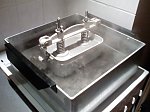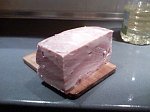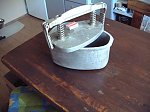Formed Hams - Basic Rules
Posted: Sun May 16, 2010 05:55
1. Commercially made hams look as if they were made from a solid piece of meat but they are actually made from many smaller cuts. These cuts can come from the same or different animals. Keep in mind that these cuts will have different colors so if you aim to produce a product of uniform color you should select these cuts carefully. Group darker pieces together and lighter pieces in a separate group.
These cuts will be molded together in a home or commercially made ham press. In order to stick together they have to develop a certain amount of "glue" which in known as an "exudate". These are basically extracted proteins, mainly myosin. The same result we get when we mix ground meat, the mixture becomes sticky and this exudate (myosin) holds the individual meat fragments together. As the common saying goes: you have to mix the meat until you get the glue ("mieszaj mieso az pusci klej").
To release myosin protein we have to apply sufficient amount of salt (2-3%). This will swell the meat cell`s structure and squeeze out the protein. That becomes much more effective if phosphate is added together with salt. The best way is to add salt and Cure #1 or Peklosol (you want a pink color) and cure meats in a refrigerator. The meats will develop the expected pink color and will be covered with sticky exudate.
Choose only lean meat as they contain the most proteins. Get rid of all skins, sinews, tendons and silver skin as those will prevent myosin from travelling to the surface. Commercial producers are in a hurry and will not cure meat in the traditional way. They will inject meats with a phosphate enriched curing solution and will have it bounced in a tumbler. This mechanical action will release proteins as well. Of course cutting and grinding will rupture more cells and will release even more proteins but such a process can be applied to luncheon meat only (szynka mielona).
2. The next step is placing the meat cuts in a ham press. Although the meat cuts are covered with sticky exudate, they have to be bonded together and some pressure is required. In order to facilitate the removal of the finished product, the meat cuts are first placed in a cooking bag and then inserted into the ham press. If the meats are placed in a mold without a cooking bag, the gel will cling to the metal surface of the press, preventing the removal of the finished product. To correct this, the press will have to be briefly inserted in hot water in order to melt down the gel inside of the press.
3. The ham press is inserted into boiling water and cooked at around 176 F, 80 C until meat reaches safe internal temperature.
4. The ham press is then cooled and inserted into the refrigerator.
5. Next day the product is removed from the mold and the delicious ham is ready to be eaten.
Note: a natural gel will form around the ham and most people are very fond of it. Children never liked this gluey substance and did not want to eat the ham. In 2001, Hormel Foods (the company that makes SPAM products) has discovered that when potato starch was added to SPAM, the gel magically disappeared. It did not go anywhere which was a good thing as the gel is a combination of natural meat juices and proteins. The potato starch helped keep the gel inside the meat. The children were eating hams again, the parents were very proud and happy, and everybody has lived happily ever after.
You can see the design of a ham press at: www.wedlinydomowe.com/ham/formed-ham.htm
These cuts will be molded together in a home or commercially made ham press. In order to stick together they have to develop a certain amount of "glue" which in known as an "exudate". These are basically extracted proteins, mainly myosin. The same result we get when we mix ground meat, the mixture becomes sticky and this exudate (myosin) holds the individual meat fragments together. As the common saying goes: you have to mix the meat until you get the glue ("mieszaj mieso az pusci klej").
To release myosin protein we have to apply sufficient amount of salt (2-3%). This will swell the meat cell`s structure and squeeze out the protein. That becomes much more effective if phosphate is added together with salt. The best way is to add salt and Cure #1 or Peklosol (you want a pink color) and cure meats in a refrigerator. The meats will develop the expected pink color and will be covered with sticky exudate.
Choose only lean meat as they contain the most proteins. Get rid of all skins, sinews, tendons and silver skin as those will prevent myosin from travelling to the surface. Commercial producers are in a hurry and will not cure meat in the traditional way. They will inject meats with a phosphate enriched curing solution and will have it bounced in a tumbler. This mechanical action will release proteins as well. Of course cutting and grinding will rupture more cells and will release even more proteins but such a process can be applied to luncheon meat only (szynka mielona).
2. The next step is placing the meat cuts in a ham press. Although the meat cuts are covered with sticky exudate, they have to be bonded together and some pressure is required. In order to facilitate the removal of the finished product, the meat cuts are first placed in a cooking bag and then inserted into the ham press. If the meats are placed in a mold without a cooking bag, the gel will cling to the metal surface of the press, preventing the removal of the finished product. To correct this, the press will have to be briefly inserted in hot water in order to melt down the gel inside of the press.
3. The ham press is inserted into boiling water and cooked at around 176 F, 80 C until meat reaches safe internal temperature.
4. The ham press is then cooled and inserted into the refrigerator.
5. Next day the product is removed from the mold and the delicious ham is ready to be eaten.
Note: a natural gel will form around the ham and most people are very fond of it. Children never liked this gluey substance and did not want to eat the ham. In 2001, Hormel Foods (the company that makes SPAM products) has discovered that when potato starch was added to SPAM, the gel magically disappeared. It did not go anywhere which was a good thing as the gel is a combination of natural meat juices and proteins. The potato starch helped keep the gel inside the meat. The children were eating hams again, the parents were very proud and happy, and everybody has lived happily ever after.
You can see the design of a ham press at: www.wedlinydomowe.com/ham/formed-ham.htm



